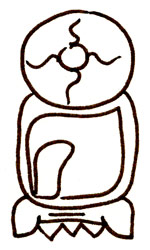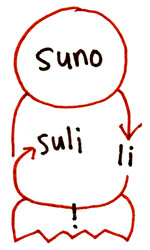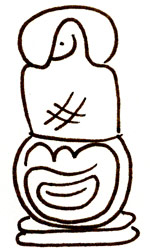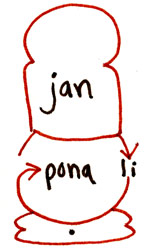lesson 3: basic sentences | jan | | mi | | moku | | sina | | suno |  | |  | |  | |  | |  | | | | | | | | | | | | | telo | | pona | | suli | | li | | |  | |  | |  | |  | |
(.) | | (!) | | |  | sentences with mi or sina as the subject
When building sentences, we work from top to bottom, and from left to right. Both the sentences above work from the top down. With simple sentences of only two words, you have the choice to stack the glyphs, or place them side by side: |
| Don't be confused when one glyph appears "tucked behind" the other. This has more to do with legibility than word order. Notice above, mi is behind pona in mi pona, is resting on moku in the vertical mi moku, and is in front of moku in the horizontal mi moku. All of these variations are acceptable, and as you work through more complex sentences, you will start to notice situations where one looks better than another. | punctuation | Notice in both variations of mi moku, above, the period (.) glyph runs horizontal along the bottom. This will always be the case. Punctuation marks at the end of sentences work like pedestals for the sentence block to rest upon. We will look at both the period (.) and the exclamation point (!) in this chapter: | sentences without mi or sina. | When writing with the Latin Alphabet, li seperates the subject from the verb. It works similarly here, by acting as a container for the verb. li is nothing more than a line which runs out of the subject, and around the verb. Remember, down and to the right, so li must follow this pattern: |
suno li suli! |  |  | jan li pona. |  |  | |